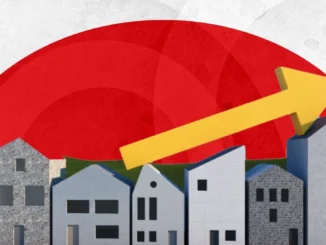
“Recovery year” was the theme heading into 2024 as mortgage professionals hoped for some reprieve in a frozen housing market characterized by high interest rates, low inventory levels and sluggish sales.
A little more than two months into the year, however, mortgage rates are the highest they’ve been as the U.S. economy remains hot.
It’s still the first quarter of 2024, so it may be too early to be pessimistic about the current mortgage rate environment, but it’s becoming more likely that a much anticipated cut in benchmark rates from the Federal Reserve won’t come until the summer of 2024.
“I didn’t think mortgage rates would level off or go down right away,” said Andrew Carter, national senior vice president of market growth at Stockton Mortgage.
“I thought they were going to be steady at where they’ve been, and then eventually I think it’s going to go down a little bit in 2024, but not not as much as people think it is.”
Many investors had expected the Fed to cut benchmark rates as early as March, and loan officers had hoped to see a decline in mortgage rates that tend to move in tandem with long-term yields.
The originators who are weathering the industry headwinds told HousingWire that a significant decline in mortgage rates is no longer expected.
“Generally speaking, originators did not expect mortgage rates to be as high as they are right now. But look, I think a lot of it is wishful thinking. The refinance boom lasted three years. Why would the higher rate environment not last as long?” said Craig Strent, former CEO of Apex Home Loans and head of the faculty of mentors at The Loan Atlas, a mortgage coaching platform.
“A lot of people are going after not a lot of deals, and it’s easy to fall into a race to the bottom and get commoditized. It’s a survival of the people that are doing the right things,” Strent added.
The high-performing LOs are not putting a lot of focus on a potential decline in mortgage rates. Rather, their priorities are buyer education and the nurturing and building of more referral relationships to expand their market share, loan originators who spoke to HousingWire said.
Two types of homebuyers
“For every five phone calls I have, only one out of five of those will actually supply paperwork. They want to know what the rates are and they say it’s too high,” said Justin Wood, production manager at CMG Financial.
Many of his buyers are still waiting for rates to come down before seeking preapproval for a mortgage. On the other hand, some buyers see the value of getting a higher-rate mortgage in the current environment.
Having a fully preapproved mortgage, buyers will be able to jump on the opportunity more quickly when they find the home they’ve been looking for, Wood explained.
These are the borrowers who know it’s unrealistic to get mortgage rates as low as 3% and realize a drop in mortgage rates will entail a rise in list prices due to lower levels of housing inventory.
What’s changed about first-time homebuyers is that they no longer expect to get mortgages at 4% levels like they did during the COVID-19 pandemic, said Khash Saghafi, a loan officer at Liberty Home Mortgage Corp.
Saghafi has clients who recently decided to pull the trigger and move to a bigger house by selling their home that had a 2.375% mortgage rate.
The couple was quoted 7% for a $500,000, three-bedroom home in early March, and they decided to go ahead with the purchase as they expect to refinance the mortgage when rates eventually decline.
“What I tell all loan officers, no matter who I talk to, is that there’s no foreclosure crisis coming on the horizon,” Saghafi said. “For that reason, real estate prices are only going in one direction — and that’s up. So, whatever you’re looking at today, it’s going to be more expensive 12 months from now.”
Priorities for successful originators
Educating borrowers on the reasons why they should be in the market now is crucial in adding value, Saghafi and other mortgage professionals emphasized.
“Even though the rates are higher now, I think it’s a great market for a first-time homebuyer,” Saghafi said. “Interest rates going up definitely cooled the market, but overall, that is not the problem.”
The rationale behind this thinking is that if a borrower can afford their current monthly mortgage payment, they can always refinance when rates drop, rather than waiting until rates decline only to see home prices soar.
“I have spoken to multiple people that feel trapped in their home,” Strent said. “They say, ‘Why would I sell my $600,000 home at 3.5% to buy a $1 million house at 7%?’ That 7% rate is high now, but you’re going to refinance. If you wait for rates to drop to 5%, that $1 million house is going to be $1 million because everybody else is going to want it.”
Mike Simonsen, founder and president of real estate analytics company Altos Research, expects home prices to climb for the rest of the spring and peak in June.
“There are buyers on the sidelines and if rates were to finally fall again, you’ll see inventory fall with new bidders, you’ll see fewer price reductions and you’ll see the leading indicators of home sales prices … climb over last year,” Simonsen wrote in recent commentary.
According to Michael Clark, vice president at Primary Residential Mortgage, there’s no secret to grabbing market share — it’s about doing outbound sales activities, addressing agents’ fears and adding value for them.
“Our philosophy is, ‘Go help agents that are sending you buyers.’ Market their listings; go to their listings. By doing so, you are adding value to their marketing efforts and getting them a contract even if you don’t write a loan on that home,” Clark said.
When an agent sees this effort, they will be more likely to send buyers, refer the loan officer to other agents through word of mouth, and even pick up some clients at an open house.
Clark’s team of 73 loan originators who cover the East Coast funded $81 million in loans in January 2024, up 35% from January 2023. More than 20 of his LOs produced at least $1 million in volume during the opening month of this year and 10 of them topped $2 million.
“All those guys weren’t doing that much volume in 2019,” Clark noted.
U.S. mortgage origination volume is expected to be $2 trillion in 2024 and $2.3 trillion in 2025, according to forecasts from the Mortgage Bankers Association (MBA). For comparison, lenders funded $2.4 trillion in first-lien mortgages in 2019, prior to the pandemic.
“Buyers are shopping left and right, but we don’t get shopped. Why? Because there’s an actual relationship — we are their mortgage adviser,” Clark said. “We’re not just some transaction coordinator that is trying to push paper to a closing table.”
“I always tell our loan officers and our team, activity breeds activity,” Wood said. “There’s a tough market out there for sure, but I think it’s creating a lot of good opportunities for people that are ready to go and serious about buying.”



